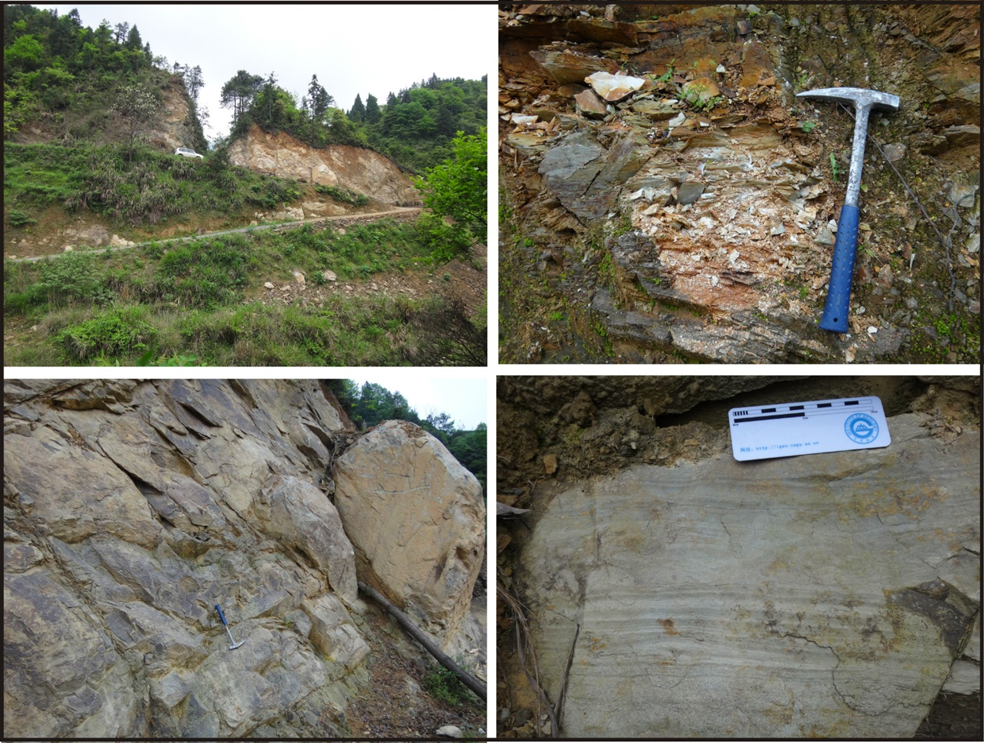Chang’an Fm
Type Locality and Naming
Northernmost Guangxi. The Chang’an Fm was named by Wang Yuelun in 1936. The typical section is located in Shixian, Sanjiang County, Guangxi Zhuangzhu Zizhiqu (Guangxi Zhuang Autonomous Region).
[Figure: Three glaciations from north to south in the South China Craton. Photos show the dropstones in the bottom of Chang’an Fm]
Synonym: (长安组)
Lithology and Thickness
The Chang’an Fm is dominated by massive pebbly mudstone intercalated with metamorphic fine-grained sandstone, siltstone and slate. Based on the lithologic characters, it can be subdivided into two members. Lower member is characterized by increasing intercalations of mudstone without gravel. Upper member is commonly composed of pebbly sandstone or pebbly mudstone. The lithology and thickness of the Chang’an Formation are both obviously varied in different areas, of which the thickness varies form 125 to 2168 m. [Implied to be largely glacial till – see Additional Information.]
[Figure: Chang’an Formation in Tiechuan Town, Hunan Province]
Relationships and Distribution
Lower contact
It is conformably on the underlying the Gongdong Fm in north Guangxi (column 57) or the Longli Fm in southeast Guizhou (column 56).
Upper contact
The top is conformably overlain by the Fulu Fm
Regional extent
The lithologic facies around Longsheng and Ziyuan is changed to pebbly gritstone, arkose, feldspathic quartzose sandstone, pelitic sandstone and calcareous sandstone.
GeoJSON
Fossils
Age
Depositional setting
The origin of the Chang'an Formation is still disputed: one opinion holds it to be the glacial sediments (tillite, by Liu Hongyun et al.); but the other, a debris flow deposit (by Liu Baojun et al.)
Additional Information
[Figure: Chang’an Formation in Tiechuan Town, Hunan Province]
Lithology-pattern: Glacial till
Relationships and Distribution:
Lower contact:
It is conformably on the underlying the Gongdong Fm in north Guangxi (column 57) or the Longli Fm in southeast Guizhou (column 56).
Upper contact:
The top is conformably overlain by the Fulu Fm
Regional extent:
The lithologic facies around Longsheng and Ziyuan is changed to pebbly gritstone, arkose, feldspathic quartzose sandstone, pelitic sandstone and calcareous sandstone.
GeoJSON: { "type": "Feature", "properties": { "id": null, "NAME": "Fulu Fm (#56, 57)" }, "geometry": { "type": "MultiPolygon", "coordinates": [ [ [ [ 109.69, 24.44 ], [ 108.92, 24.39 ], [ 108.55, 24.41 ], [ 108.38, 24.79 ], [ 108.39, 25.04 ], [ 108.39, 25.36 ], [ 108.59, 25.95 ], [ 109.03, 26.46 ], [ 109.74, 26.87 ], [ 110.55, 27.08 ], [ 110.74, 26.77 ], [ 110.35, 26.28 ], [ 110.18, 25.9 ], [ 109.69, 24.44 ] ] ] ] } }
Fossils:
Age:
early Nanhuan (early Cryogenian). SHRIMP zircon U-Pb date of 778±7 Ma is from a volcanic ash bed in the Chang’an Fm in the Luocheng section in Guangxi Province (Gao Linzhi et al., 2014). However, according to Gaoyuan Song et al. (2017. New U-Pb age constraints on the upper Banxi Group and synchrony of the Sturtian glaciation in South China. Geoscience Frontiers, 8: 1161-1173; https://doi.org/10.1016/j.gsf.2016.11.012), it is synchronous with the Jiangkou Fm glacial (Sturtian of Cryogenian)
Age span:
Beginning stage: Cryogenian
Fraction up in beginning stage: 0.0
Beginning date (Ma):
Ending stage: Cryogenian
Fraction up in ending stage: 0.7
Ending date (Ma):
Depositional setting:
The origin of the Chang'an Formation is still disputed: one opinion holds it to be the glacial sediments (tillite, by Liu Hongyun et al.); but the other, a debris flow deposit (by Liu Baojun et al.)
Depositional-pattern:
Additional Information

